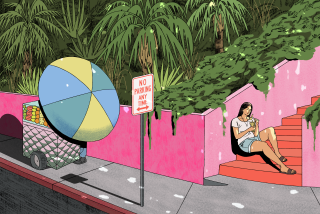The Middle Ages: As we pack up, a bittersweet ode to a workplace that was my second home
To me, the Los Angeles Times building has always looked like a gigantic tombstone.
Indeed, people have died here – literally, at their desks, or figuratively, seeing their careers slowly crash and burn, which could be even worse.
Inside and out, a newspaper can be a lethal operation. This particular paper brought down petty crooks and prideful barons and, most recently, a chancellor. It made Richard Nixon’s career, and has been all over the current president.
The Times is located at the vortex of privilege and sanctimony, a squat, imposing, limestone shoebox soaked in smog and surrounded by courtrooms and mouthy politicians.
Other halls of power seem to cling to it. Even the cops nestled in next door almost a decade ago — and there you had it: City Hall, the LAPD and their snarly watchdog, the Los Angeles Times.
Going to miss us, Mister Mayor? Yeah, I’ll bet.
The Chandler family built the current digs for 4 million bucks in the middle of the Great Depression, then used them to crowbar L.A. history. Drinking water, port locations, the Valley were all on the to-do list. Even Olvera Street has Times fingerprints all over it, championed by Harry Chandler to honor the city’s Mexican roots.
The voice for Manifest Destiny, the pug of civic pride, Chandler wanted people to move west to Los Angeles. These days, can you even imagine that being a problem? But he did.
The Chandlers got very rich on real estate and publishing, grew the arts, built an Oscar-worthy music hall and, best of all, produced a golden son, Otis, with a movie-star chin but a papal heart.
Between 1960-1980, Otis would turn the L.A. Times into a swaggering, world-class beacon of light.
I’ve worked down here for nearly 30 years, in a lot of different gigs, under a lot of editors, some pretty good. It’s not a screamy, in-your-face newsroom like you see in movies. You can go hours now without hearing anyone curse out another person. Indeed, the newsroom is mostly quiet, cunning, careful and — when on its game — damn good.
The most successful employees live and breathe the place. The current top editors of the New York Times and the Washington Post both polished their game in major roles here.
Of course, reporters and editors think of the paper only as the newsroom, with the hubris of second lieutenants. That is so not so. Great and talented co-workers toil long hours in advertising, circulation, marketing and many other roles.
The music may be written in the newsroom, but it is played in production, where people get their hands dirty … they lose fingers. The violent roar of the presses proves daily that this is still a bloody, awful, beautiful business. The presses, which are in a separate building on the edge of downtown, will remain there.
But the rest of us are leaving the city’s core because desperate bottom-liners sold the joint for cash two years ago, and now we are merely a tenant facing confiscatory rents.
So before packing up, I brought in 180 readers for tours, to pay their respects and knock around a newsroom that — with their support — produced 44 Pulitzers.
The readers loved the entrance, with flecks of gold in the marble walls. They loved the gleaming test kitchen, the enormous newsroom that stretches an entire city block and the story of how one employee once lived secretly in the basement, our very own Phantom.
Leading the charge was Darrell Kunitomi, who has been at The Times for 40 years, in public affairs and other roles. For years, he has led free public tours that have now concluded as we approach our departure day. Witty and well-versed, Darrell has been the treasure within the treasure.
His farewell tours were bittersweet. We operate, as I said, in this vortex of power and we prattle along at the hub of perhaps the most creative city in the world. Finally, after decades of decline, downtown is back and we are heading to El Segundo.
Goodbye, Redwood. So long, Grand Central Market. You know, a lot of us grew up at this old stone castle.
Here in downtown Los Angeles, we have published a paper daily, without fail, since 1881, through blackouts and quakes, riots and a ferocious union bombing that claimed 21 lives.
Darrell took us through all that. And when the tour was done, in true newspaper fashion, the readers toasted their day with a frosty beverage at Far Bar, a local watering hole with 500 coats of varnish and brass hooks still on the wall. Like a newsroom, a good dive opens early and closes way after midnight.
“May newspapers never go away,” said one reader, raising a sweaty beer.
May they never.
Twitter: @erskinetimes



